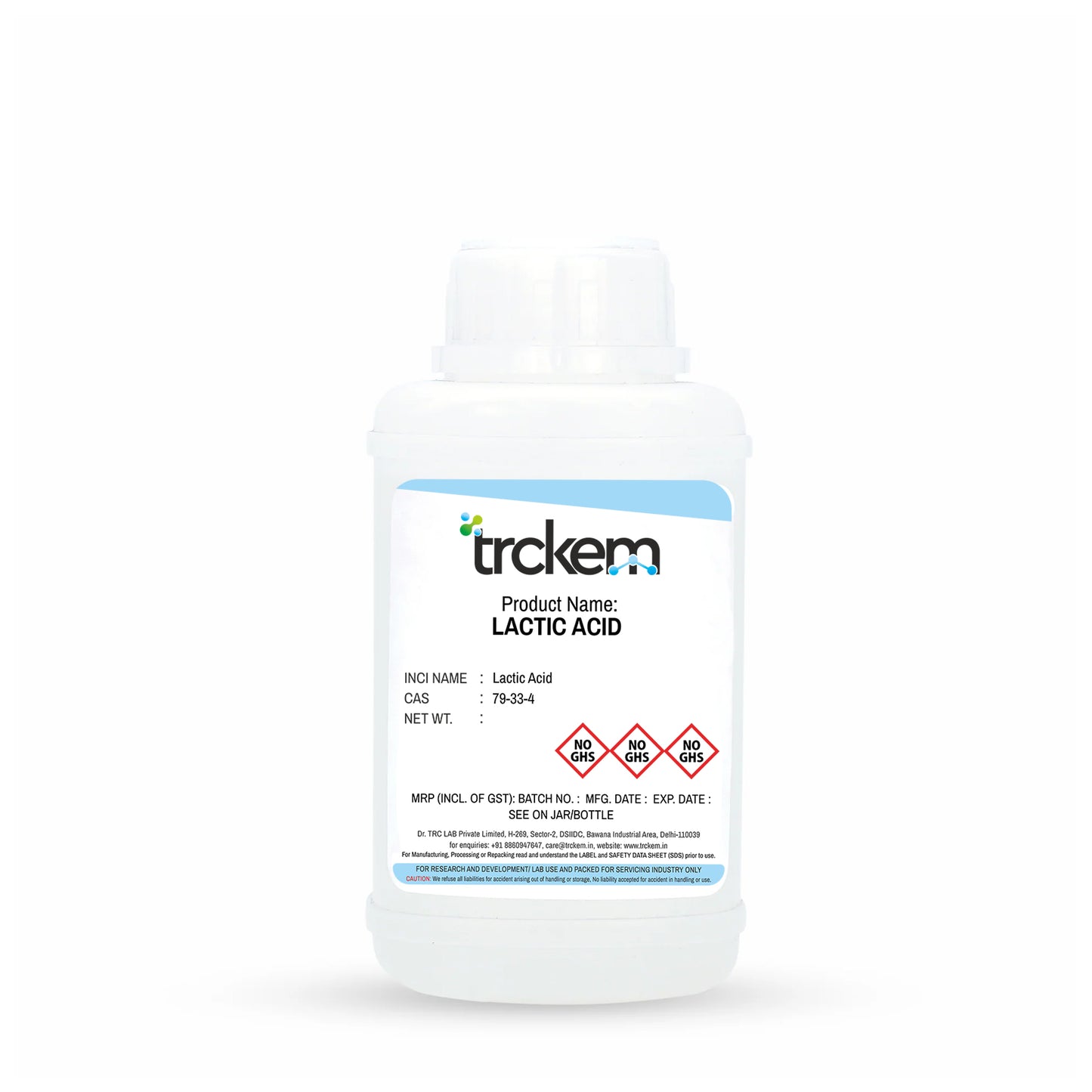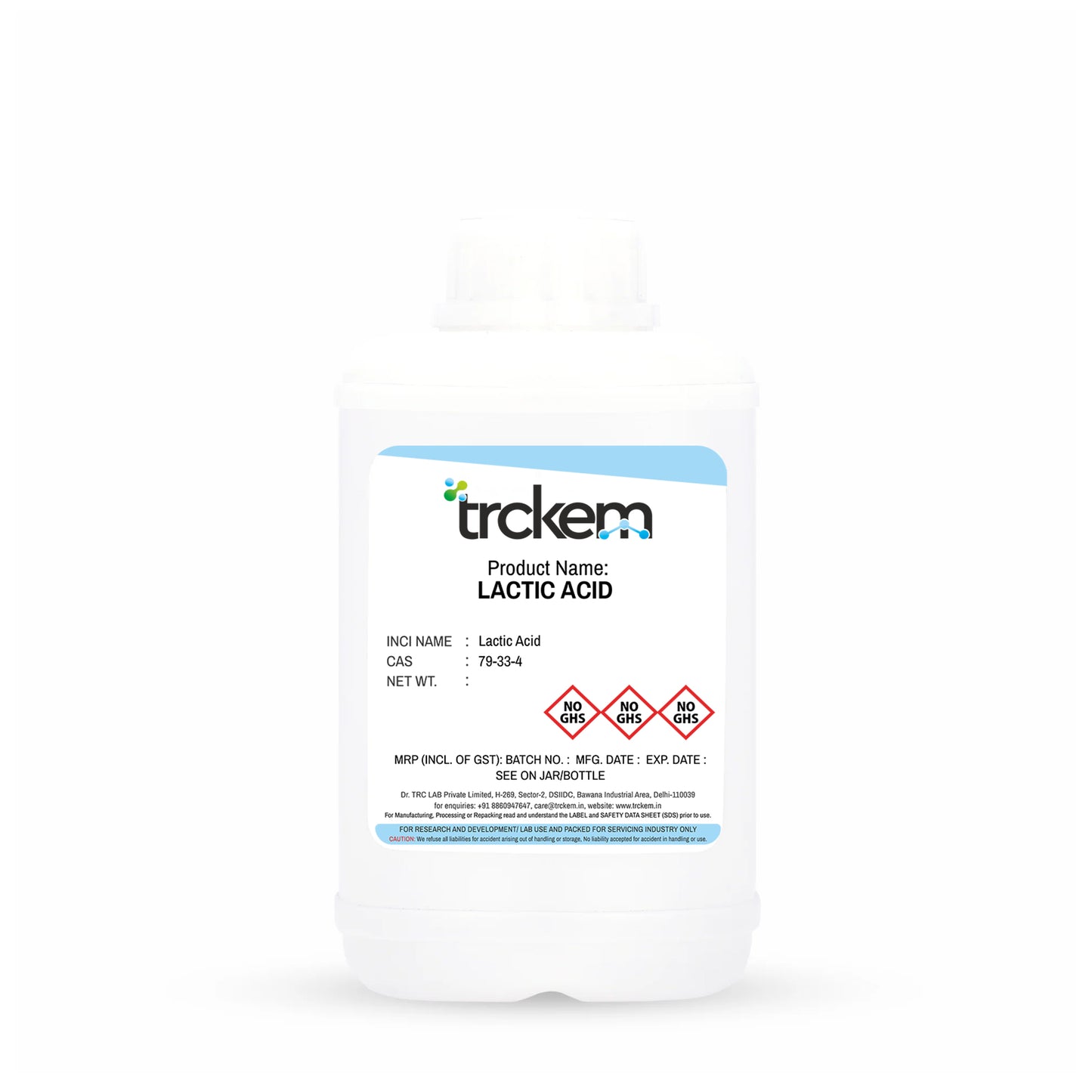

THE STORY OF LACTIC ACID

Lactic Acid: The Gentle AHA for Smooth, Hydrated & Radiant Skin
Lactic Acid is a mild Alpha Hydroxy Acid (AHA) known for its exceptional ability to exfoliate, brighten, and hydrate the skin.
It gently removes dead cells, improves texture, enhances radiance, and supports moisture retention — making it perfect for sensitive to normal skin types.
Commonly used in serums, peels, cleansers, lotions, and body-care products.

Bio-Fermented AHA Derived from Natural Sugars & Milk Components
Cosmetic-grade Lactic Acid is produced through fermentation of natural sugars such as:
• Glucose
• Corn starch
• Beet sugar
This fermentation creates a biocompatible, skin-friendly AHA.
It is then purified into a liquid or powdered form with controlled concentration.
TRCkem provides cosmetic- and pharmaceutical-grade Lactic Acid ideal for exfoliating and hydrating skincare systems.

Exfoliate. Brighten. Renew.
Lactic Acid delivers multiple skin benefits:
✅ Gently exfoliates dead skin cells
✅ Improves smoothness & brightness
✅ Strengthens the skin barrier
✅ Enhances natural hydration due to its humectant properties
✓ Helps reduce the appearance of spots, texture, and dullness
Used in: serums, lotions, exfoliating toners, chemical peels, body-care products, foot creams & cleansers.

Effective & Skin-Friendly — Use in pH-Balanced, Controlled Formulations
• Typical use level:
– 1–12% in skincare
– 20–30% for controlled professional peels
• Works best at pH 3.0–4.5
• Add during cooling phase to avoid degradation
• Avoid strong sun exposure after use — apply SPF in daytime formulas
• Non-irritating when properly neutralized
• Store tightly sealed, away from heat & moisture
• Safe for sensitive skin when used in mild strengths
Formulator’s Queries, We Answered
1. What is Lactic Acid?
Lactic Acid is a naturally occurring alpha-hydroxy acid (AHA) derived from milk, fruits, or plant-based fermentation. It is widely used in personal care products for its exfoliating, hydrating, and pH-regulating properties, making it a popular ingredient in skincare formulations.
2. What is the CAS number and INCI name of Lactic Acid?
CAS Number: 50-21-5
INCI Name: Lactic Acid
3. What are the benefits of Lactic Acid in personal care products?
Lactic Acid is valued for its:
Gentle Exfoliation: Removes dead skin cells, improving texture.
Skin Brightening: Helps fade dark spots and hyperpigmentation.
Hydration Boosting: Acts as a humectant, attracting moisture to the skin.
pH Regulation: Helps maintain the skin's natural acid mantle.
Collagen Stimulation: Promotes firmer, smoother skin.
4. How does Lactic Acid work in cosmetic formulations?
Lactic Acid functions as a mild chemical exfoliant, breaking down bonds between dead skin cells to reveal smoother, brighter skin. It also enhances hydration levels by attracting water molecules and improving overall skin barrier function.
5. Is Lactic Acid suitable for all skin types?
Lactic Acid is generally well-tolerated but works best for:
Dry & sensitive skin (gentler than other AHAs like glycolic acid).
Dull & uneven skin tones (brightens and refines texture).
Mature skin (boosts collagen and hydration).
Acne-prone skin (helps unclog pores and reduce breakouts).
Note: Those with very sensitive or compromised skin should use it in lower concentrations to avoid irritation.
6. What types of personal care products contain Lactic Acid?
Lactic Acid is commonly found in:
Facial cleansers & exfoliants
Serums & chemical peels
Moisturizers & toners
Body lotions & foot creams
Anti-aging & brightening treatments
7. Can Lactic Acid be combined with other ingredients?
Yes, Lactic Acid works well with:
Hyaluronic acid for hydration.
Niacinamide for brightening effects.
Ceramides to strengthen the skin barrier.
AHAs/BHAs for enhanced exfoliation (used with caution).
Avoid combining Lactic Acid with:
High concentrations of Vitamin C (may cause irritation).
Strong retinoids (can increase sensitivity).
8. Does Lactic Acid cause any side effects?
While Lactic Acid is generally mild, potential side effects include:
Mild irritation or redness, especially for sensitive skin.
Increased sun sensitivity (always use sunscreen when using AHAs).
9. What is the recommended concentration of Lactic Acid in personal care formulations?
5% to 10% for daily use in cleansers and moisturizers.
10% to 15% for exfoliating serums and toners.
20% to 30% for professional chemical peels (under expert supervision).
10. Is Lactic Acid natural or synthetic?
Lactic Acid can be naturally derived from fermented plant sugars or dairy but is also produced synthetically for stability and purity in cosmetic formulations.
11. Where can I purchase high-quality Lactic Acid for formulation purposes?
Lactic Acid is available from cosmetic raw material suppliers, pharmaceutical distributors, and specialty chemical manufacturers. Look for cosmetic or pharmaceutical-grade Lactic Acid for safe formulation use.




